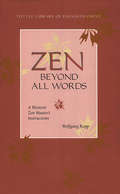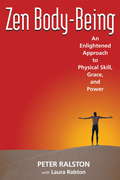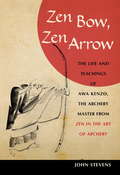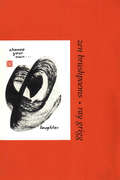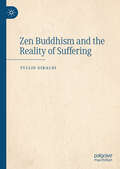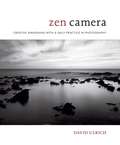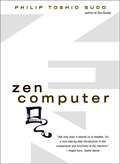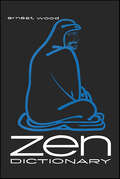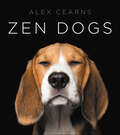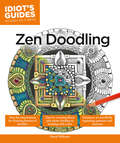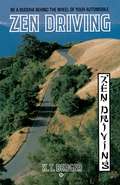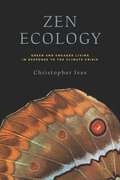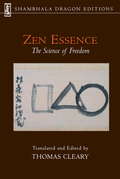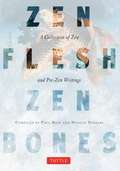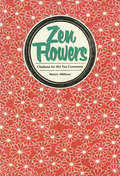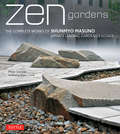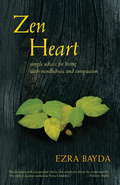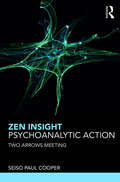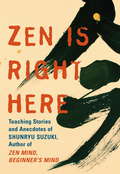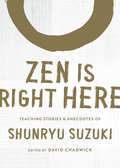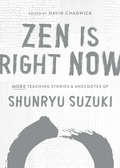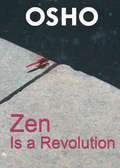- Table View
- List View
Zen Beyond All Words
by Wolfgang Kopp Barbara Wittenberg-HaenauerZen Beyond All Words contains a selection of talks given by MasterWolfgang Kopp at the Tao Ch'an Center in Wiesbaden, Germany, during the summer of 1992. In the spirit of the ancient Chinese Ch'an masters, Wolfgang Kopp teaches a direct and powerful Zen. He conveys neither a theoretical system nor a one-sided dogmatism of sitting, and he neither wears customary robes nor holds a traditional title.
Zen Body-Being: An Enlightened Approach to Physical Skill, Grace, and Power (Zen Buddhism Ser.)
by Peter Ralston Laura RalstonIn this inspiring guide, Peter Ralston presents a program of "physical education" for anyone interested in body improvement. Using simple, clear language to demystify the Zen mindset, he draws on more than three decades of experience teaching students and apprentices worldwide who have applied his body-being approach. More of a transformative guide than a specific list of exercises devoted to any particular physical approach, Zen Body-Being explains how to create a state of mental control, enhanced feeling-awareness, correct structural alignment, increased spatial acuity, and even a greater interactive presence. Exercises are simple, often involving feeling-imagery and meditative awareness, which have a profound and sometimes instant effect. Where similar guides teach readers what to do, this book teaches readers how to be.From the Trade Paperback edition.
Zen Bow, Zen Arrow: The Life and Teachings of Awa Kenzo, the Archery Master from Zen in the Art of A rchery
by John StevensHere are the inspirational life and teachings of Awa Kenzo (1880-1939), the Zen and kyudo (archery) master who gained worldwide renown after the publication of Eugen Herrigel's cult classic Zen in the Art of Archery in 1953. Kenzo lived and taught at a pivotal time in Japan's history, when martial arts were practiced primarily for self-cultivation, and his wise and penetrating instructions for practice (and life)--including aphorisms, poetry, instructional lists, and calligraphy--are infused with the spirit of Zen. Kenzo uses the metaphor of the bow and arrow to challenge the practitioner to look deeply into his or her own true nature.
Zen Brushpoems
by Ray GriggZen Brushpoems connects the creative insights of Haiku-like poetry with the dynamic interplay of the written word and painted image. This subtle and profound medium of poetic expression has been inspired by the revolutionary work of Paul Reps
Zen Brushpoems
by Ray GriggZen Brushpoems connects the creative insights of Haiku-like poetry with the dynamic interplay of the written word and painted image. This subtle and profound medium of poetic expression has been inspired by the revolutionary work of Paul Reps
Zen Brushpoems
by Ray GriggZen Brushpoems connects the creative insights of Haiku-like poetry with the dynamic interplay of the written word and painted image. This subtle and profound medium of poetic expression has been inspired by the revolutionary work of Paul Reps
Zen Brushpoems
by Ray GriggZen Brushpoems connects the creative insights of Haiku-like poetry with the dynamic interplay of the written word and painted image. This subtle and profound medium of poetic expression has been inspired by the revolutionary work of Paul Reps
Zen Buddhism and the Reality of Suffering
by Tullio GiraldiThis book offers an accessible guide to the role that Zen has played and, alongside Buddhism, might play in both Eastern and Western attempts to alleviate mental suffering. Since its beginnings 2500 years ago, the central belief of Buddhism has been that what we perceive as “reality” is a mental representation; a religious belief which has since been substantiated by the evidence of neuroscience. The work and progress of clinical medicine, psychiatry and psychology have attempted to alleviate the sufferings of life, but the current approaches to mental health in psychiatry, the neurosciences and cognitivism don't fully address the complexity and mutual inter-relationship of the variety of factors involved in mental suffering, and its non-linear and chaotic aspects. Zen Buddhism, on the other hand, encourages access to reality, and so this book will explore, scientifically, the ways in which it’s guiding principles can be deployed to support and enhance Western, clinical solutions to mental strife.
Zen Camera: Creative Awakening with a Daily Practice in Photography
by David UlrichZen Camera is an unprecedented photography practice that guides you to the creativity at your fingertips, calling for nothing more than your vision and any camera, even the one embedded in your phone. David Ulrich draws on the principles of Zen practice as well as forty years of teaching photography to offer six profound lessons for developing your self-expression. Doing for photography what The Artist’s Way and Drawing on the Right Side of the Brain did for their respective crafts, Zen Camera encourages you to build a visual journaling practice called your Daily Record in which photography can become a path of self-discovery. Beautifully illustrated with 83 photographs, its insights into the nature of seeing, art, and personal growth allow you to create photographs that are beautiful, meaningful, and uniquely your own.You’ll ultimately learn to change the way you interact with technology—transforming it into a way to uncover your innate power of attention and mindfulness, to see creatively, and to live authentically.
Zen Computer
by Philip Toshio SudoJapanese-American musician Sudo (</Zen Guitar/>) assumes the reader has just acquired a new piece of software and needs to learn how to install and use it. Drawing from eastern philosophy, he sets out seven principles to avoid frustration: Expect the unexpected. It always takes longer than you think. Do not waste time. Learn and teach, teach and learn. Warm heart, cool head. Do good work. and Know when to turn the machine off. He has not indexed his series of short articles. Annotation c. Book News, Inc. , Portland, OR (booknews. com)
Zen Dictionary: Zen Dictionary And Zen And Shinto (Pelican Ser.)
by Ernest WoodA helpful A-to-Z guide to the terms, central concepts, and history of Zen Buddhism by the acclaimed scholar and author of Concentration. From the seemingly unlimited field of knowledge and sayings by Zen masters, theosophist Ernest Wood has carefully compiled a reference guide that details the most important Zen ideas, along with a general history of the growth of Zen in China and Japan. Presenting names and terms in alphabetical order, Zen Dictionary is an ideal reference text for any student of Zen. From the seemingly unlimited field of knowledge and sayings by Zen masters, theosophist Ernest Wood has carefully compiled a reference guide that details the most important Zen ideas, along with a general history of the growth of Zen in China and Japan. Presenting names and terms in alphabetical order, Zen Dictionary is an ideal reference text for any student of Zen.
Zen Dogs
by Alex CearnsAward-winning animal photographer Alex Cearns celebrates the peace, calm, and joy dogs bring to our lives with this unique full-color collection capturing eighty dogs in their most relaxed and contented moments.When Alex Cearns caught Suzi the Sharpei on film with eyes closed and an endearing smile on her furry face, the renowned Australian professional pet and wildlife photographer called the picture of serenity "Zen Dog." Captivated by the image’s tranquil beauty, Cearns then turned her lens on other canines experiencing their own carefree and meditative "Zen" moments—a series of photos that would go viral across the web and take the top prize in a major international competition.Expanding on Cearns’s original web series, Zen Dogs includes eighty stunning color photographs of a variety of breeds—golden retrievers, beagles, French bulldogs, dachshunds, poodles, huskies, pit bulls, and German shepherds. Here are some familiar faces from the online series, joined by dozens of dogs never seen before—all whose engaging personalities shine through. Sprinkled throughout the photos are words of wisdom from the Buddha, Eckhart Tolle, Thich Nhat Hanh, and other meditative masters, inspiring messages that, with the photos, warm the heart and soothe the spirit.A gorgeous compendium for every dog lover, animal enthusiast, and everyone looking to add some peace and joy to their day, Zen Dogs reminds us of the power dogs have to enrich our lives—to make us happier, healthier, calmer, and more loving.
Zen Doodling (Idiot's Guides)
by David WilliamsDoodling isn't necessarily a mindless pursuit. There's hidden discipline, order, and joy behind artful scribbles. Idiot's Guides: Zen Doodling gives readers beautiful, full-color instruction and all they need to start using ordered, repeated "tangle" designs that are great creative expressions and works of art unto themselves. The book includes step-by-step instructions for drawing more than 20 doodle forms and patterns.
Zen Driving: Be a Buddha Behind the Wheel of Your Automobile
by K. T. BergerBe a buddha behind the wheel of your automobile.
Zen Ecology: Green and Engaged Living in Response to the Climate Crisis
by Christopher IvesDiscover a way of living that can help you slow down and stay grounded—and at the same time reduce your ecological impact and engage more fully with the climate crisis.It may seem as though living ecologically and engaging in activism sacrifices our own enjoyment and happiness on the altar of doing the right thing. In this book, professor, naturalist, and Buddhist author Christopher Ives offers an alternative: a way of living that can actually be more fulfilling than the modern consumerist lifestyle. Rather than deprivation, it can bring us richness. In Zen Ecology, Chris outlines his environmental ethic as a series of concentric circles, beginning with ourselves and then moving outward into our communities, all the while focusing on spaciousness, mindfulness, generosity, and contentment. At the individual level, we deal with distraction, clutter, and ecological harm. Here, Chris offers ways to help us pay attention, simplify our lives, and lower our impact. Then, we explore how to envision our home as a &“place of the Way,&” with Zen monastic life as a model for this—without having to be a monk! Next, we realize our embeddedness in nature and emplace ourselves in community with others, including other forms of life. Finally, we build on this basis to engage in activism to create a world that is more supportive of ecological health and spiritual fulfillment. In this way, we avoid the two extremes of apathy and burnout, and uncover a way of living that is simple, joyful, embedded in nature, connected to others in community, and supportive of collective action.
Zen Essence
by Thomas ClearyDrawn from the records of Chinese Zen masters of the Tang and Song dynasties, this collection may surprise some readers. In contrast to the popular image of Zen as an authoritarian, monastic tradition deeply rooted in Asian culture, these passages portray Zen as remarkably flexible, adaptive to contemporary and individual needs, and transcending cultural boundaries.The readings contained in Zen Essence emphasize that the practice of Zen requires consciousness alone and does not depend on a background in Zen Buddhism and Asian culture. The true essence of Zen resides in the relationship between mind and culture, whatever that culture might be. This unique collection of writings creates a picture of Zen not as a religion or philosophy, but as a practical science of freedom.
Zen Flesh, Zen Bones: A Collection of Zen and Pre-Zen Writings
by Paul Reps Nyogen Senzaki"Zen Flesh, Zen Bones" is four books in one - books that would rank high in the canon of Zen, if Zen were so non-Zen as to have scriptures. "101 Zen Stories" recounts experiences of Chinese and Japanese Zen teachers over a period of more than five centuries. "The Gateless Gate" offers a collection of 13th-century koans to sit with in practice. "10 Bulls" is a 12th-century commentary on the stages of awareness leading to enlightenment. Finally "Centering," a 4,000 year-old teaching from India, offers what some would consider to be the roots of Zen. When this book was first published in 1957 it became a guide for an entire generation of western seekers who were just beginning to explore Zen. In the years since it has inspired leading American Zen teachers, students, and practitioners. Join them.
Zen Flowers: Chabana for the Tea Ceremony
by Henry MittwerThis Zen flower arranging book teaches the delicate art of Japanese Chabana--the precursor to ikebana.<P><P>Up to now, with the exception of Okakura Kakuzo's excellent account of flowers used in the art of Chanoyu in his delightful The Book of Tea, almost nothing has been available on the subject. To my knowledge, the present volume is the only book written in English that is wholly devoted to the special form of flower arrangement called Chabana.Chabana is a type of flower arrangement that originated in the tea room . Chabana is not only for decoration, for symbolic representation, or for abstract expression of the self. 2,500years ago, Chabana has something in common with one of Shakyamuni Buddha's sermons. Buddha lightly picked a single bloom from a basketful of flowers offered to Him by one of the multitude who came to hear His sermon. Buddha slowly, silently, held up the flower before the congregation. Among the gathering was one of His disciples, Mahakasyapa, who gently smiled as he apprehended the Buddha's gesture. Chabana may not be a flower arrangement having a Zen-like mission, but it certainly is a flower arrangement appreciated by a mind nourished with the Zen principles of simplicity and directness.
Zen Gardens
by Mira Locher Uchida ShigeruShunmyo Masuno, Japan's leading garden designer, is at once Japan's most highly acclaimed landscape architect and an 18th-generation Zen Buddhist priest, presiding over daily ceremonies at the Kenkoji Temple in Yokohama. He is celebrated for his unique ability to blend strikingly contemporary elements with the traditional design vernacular. He has worked in ultramodern urban hotels and in some of Japan's most famous classic gardens. In each project, his work as a designer is inseparable from his Buddhist practice. Each becomes a Zen garden, "a special spiritual place where the mind dwells."This beautiful book, illustrated with more than 400 drawings and color photographs, is the first complete retrospective of Masuno's work to be published in English. It presents 37 major gardens around the world in a wide variety of types and settings: traditional and contemporary, urban and rural, public spaces and private residences, and including temple, office, hotel and campus venues. Masuno achieved fame for his work in Japan, but he is becoming increasingly known internationally, and in 2011 completed his first commission in the United States which is shown here.The book, divided into three chapters, covers: "Traditional Zen Gardens," "Contemporary Zen Gardens," and "Zen Gardens outside Japan." Illustrated with photographs and architectural plans or sketches, each garden is described and analyzed by author Mira Locher, herself an architect and a scholar well versed in Japanese culture.Celebrating the accomplishments of a major, world-class designer, Zen Gardens also serves as something of a master class in Japanese garden design and appreciation: how to perceive a Japanese garden, how to understand one, even how to make one yourself. Like one of Masuno's gardens, the book can be a place for contemplation and mindful repose.
Zen Heart: Simple Advice for Living with Mindfulness and Compassion
by Ezra BaydaThere's a secret to spiritual practice, and it's surprisingly simple: learn to be present with attention. Do that, and the whole world becomes your teacher, you wake up to the sacredness of every aspect of existence, and compassion for others arises without even thinking about it. In Zen Heart, Bayda provides a wealth of practical advice for making difficult experiences a valued part of the path and for making mindfulness a daily habit.
Zen Insight, Psychoanalytic Action: Two Arrows Meeting
by Seiso Paul CooperDrawing from original source material, contemporary scholarship, and Wilfred Bion’s psychoanalytic writings, Zen Insight, Psychoanalytic Action: Two Arrows Meeting introduces the Zen notion of "gūjin," or total exertion, and elaborates a realizational perspective that integrates Zen Buddhism and psychoanalysis. Developed by the thirteenth century Zen teacher and founder of the Japanese Soto Zen school, Eihei Dogen, gūjin finds expression and is referenced in various contemporary scholarly and religious commentaries. This book explains this pivotal Zen concept and addresses themes by drawing from translated source material, academic scholarship, traditional Zen kōans and teaching stories, extensive commentarial literature, interpretive writings by contemporary Soto Zen teachers, psychoanalytic theory, clinical material, and poetry, as well as the author’s thirty years of personal experience as a psychoanalyst, supervisor, psychoanalytic educator, ordained Soto Zen priest, and transmitted Soto Zen teacher. From a realizational perspective that integrates Zen and psychoanalytic concepts, the book addresses anxiety-driven interferences to deepened Zen practice, extends the scope and increases the effectiveness of clinical work for the psychotherapist, and facilitates deepened experiences for both the Buddhist and the secular meditation practitioner. Two Arrows Meeting will be of great interest to researchers in the fields of Zen Buddhism and psychoanalysis. It will also appeal to meditation practitioners and psychoanalysts in practice and training.
Zen Is Right Here: Teaching Stories and Anecdotes of Shunryu Suzuki, Author of Zen Mind, Beginner's Mind
by David ChadwickShunryu Suzuki's extraordinary gift for conveying traditional Zen teachings using ordinary language is well known to the countless readers of Zen Mind, Beginner's Mind. In Zen Is Right Here, his teachings are brought to life powerfully and directly through stories told about him by his students. These living encounters with Zen are poignant, direct, humorous, paradoxical, and enlightening; and their setting in real-life contexts makes them wonderfully accessible. Like the Buddha himself, Suzuki Roshi gave profound teachings that were skilfully expressed for each moment, person, and situation he encountered. He emphasized that while the ungraspable essence of Buddhism is constant, the expression of that essence is always changing. Each of the stories presented here is an example of this versatile and timeless quality, showing that the potential for attaining enlightenment exists right here, right now, in this very moment.
Zen Is Right Here: Teaching Stories and Anecdotes of Shunryu Suzuki, Author of Zen Mind, Beginner's Mind
by Shunryu SuzukiPersonal stories and anecdotes of the trailblazing Zen teacher Suzuki Roshi--now reissued in hardcover in tandem with the publication of the follow-up volume, Zen Is Right Now. Shunryu Suzuki&’s extraordinary gift for presenting traditional Zen teachings using ordinary language is well known to the countless readers of Zen Mind, Beginner&’s Mind. In Zen Is Right Here, his teachings are brought to life through stories told by his students. These living encounters with Zen are poignant, direct, humorous, paradoxical, and enlightening—and their setting in real-life contexts makes them wonderfully accessible. Like the Buddha himself, Shunryu Suzuki gave profound teachings that were skillfully expressed for each moment, person, and situation he encountered. He emphasized that while the essence of Buddhism is constant, the expression of that essence is always changing. Each of the stories presented here is an example of this versatile and timeless quality, showing that the potential for attaining enlightenment exists right here, at this very place.
Zen Is Right Now: More Teaching Stories and Anecdotes of Shunryu Suzuki, Author of Zen Mind, Beginner's Mind
by Shunryu SuzukiIn this new collection of quotes from Shunryu Suzuki Roshi and stories from his students, the presence, wisdom, and humor of a great Zen teacher come alive once more.The teachings of Shunryu Suzuki have served for innumerable people as the gateway to Zen practice and meditation. In Zen Is Right Now, devoted student and biographer David Chadwick sheds new light on Suzuki&’s presence and teachings through selected quotes from his lectures and a variety of stories told by his students. Complementary to another collection about Suzuki, Zen Is Right Here, this book offers a joyful bounty of anecdotes and insights, revealing a playful and deeply wise teacher who delighted in paradox and laughed often. Each of the stories and quotes presented here is an example of the versatile and timeless quality evident in Suzuki&’s teaching, showing that the potential for attaining enlightenment exists right now, in this very moment.
Zen Is a Revolution
by Osho Osho International FoundationIn this talk Osho takes his audience into the world of ZEN. "There are a few essential things which make Zen absolutely different from any kind of teaching. The most important of these essentials is that Zen is a revolution. All other religions are servants to the vested interests. The rich people and the powerful people, the politicians, have dominated all the religions. The priests have been nothing but servants to these criminals. It is such a worldwide conspiracy that no one recognizes it. It is so obvious and so simple that we are from the very beginning, from our very childhood, being programmed." From an original series: Rinzai: Master of the Irrational, by Osho.
